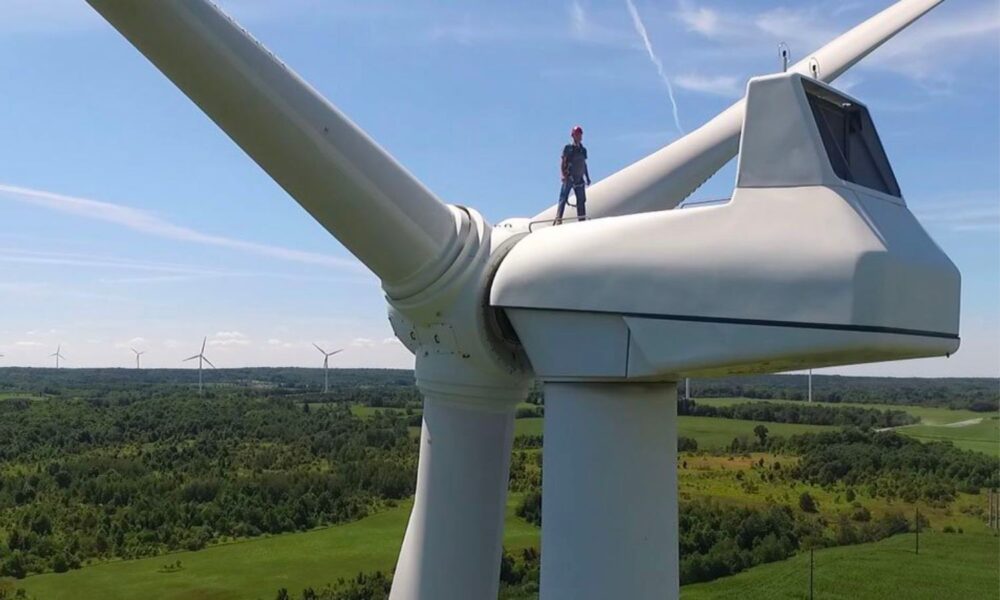We at the Union of Concerned Scientists think a lot about wind power. In honor of Global Wind Day, here’s a roundup of what we’re seeing and what we’ve been thinking—five facts about wind energy to keep in mind as you celebrate, or at least make note, on June 15.
1. Wind power is big, and getting bigger
Wind is impressive. I’ve felt that most explicitly when sidling up to an offshore wind turbine in a boat, or when standing on top of a land-based one, hundreds of feet in the air. Offshore wind turbines are particularly impressive. The ones that’ll soon be gracing areas over the horizon are powerful enough, each one, to generate the equivalent of an average home’s daily electricity use in just a few seconds.
Even more important, though, wind is an impressive piece of our electricity supply. In 2021, 9 percent of US electricity came from those graceful kinetic sculptures, up from less than 3 percent in 2011. Eight states generate more than 25 percent of their electricity from wind. Wind is now the largest source of renewable energy in the country.
And a lot more big-ness is coming. Turbines will be getting larger, both on land and in the water. Wind power generation will continue to rise, including in the near term as a result of one of the US wind industry’s best years ever in 2021. Offshore wind power, still at an early stage in the United States, is poised to grow by leaps and bounds in respond to states stepping up and an ambitious federal administration doing its part.
And US wind jobs, currently totaling more than 100,000, should grow right along with the technology and the market.

2. Wind power is a bargain
An important part of wind power’s success in recent years has been its low cost. From 2010 through 2020, the cost of electricity from wind fell more than 60 percent, according to the Department of Energy. Wind power is now cheaper than fossil fuels—even existing coal plants—in many parts of the country.
Particularly important at a time of swings in energy prices and inflation concerns, wind power pricing is also stable. Once it’s installed, no fuel costs at play means wind power can offer fixed prices over the long term.
Like wind power’s growth, wind power’s bargain-ness seems set to improve with greater scale, with experts predicting substantial cost reductions for both land-based and offshore wind.
3. We need a modern grid
Our electricity grid is old, outdated, and in desperate need of an upgrade, and while we’re upgrading it, part of what we want to do is make it easier to integrate wind and other renewables. There’s a lot standing in the way of progress that has nothing to do with wind power itself.
The good news is that there’s work being done in the right direction. The operators of our nation’s electricity grids in different parts of the country are working toward that modernization—and advocates like UCS are working to make sure they do this on the scale we need.
4. We want more wind power
Wind power has a lot of room to grow, and we want plenty more. Wind and other renewables are key for cleaning up the power sector. They’re also key for cleaning up other sectors, such as transportation—when we electrify cars, trucks, and buses—and home heating—through the rapid adoption of heat pumps.
Modeling by UCS (here and here, for example) and others shows just how big a role wind power might play in getting the country off fossil fuels.
Globally, too, wind stands to be a leader in what’s to come for fighting climate change. The most recent report from the UN Intergovernmental Panel on Climate Change showed that wind and solar had by far the greatest potential for cutting climate pollution in the energy sector, with lots of each that could be available more cheaply than the fossil fuels they’d displace.

5. We can do wind power right
As wind power continues to grow, we’re going to want to continue to find ways to do it in the best ways possible, including with regard to:
- People: That includes making sure people are at the center of our considerations as we think about how the power sector will evolve, and making sure we take advantage of opportunities for equity as we stand up new industries, like offshore wind.
- Wildlife: The best ways also include making sure we’re bringing science to bear to avoid and minimize impacts to wildlife from wind and other renewables.
- Lifecycle: And we want to make sure we keep track of the equipment involved in making wind power happen, from how we get the raw materials through to end-of-life needs and opportunities.
Celebrate
So go ahead, celebrate. Global Wind Day comes but once a year, and there’s a lot worth noting about what we’re doing right, and about what more is to come.

